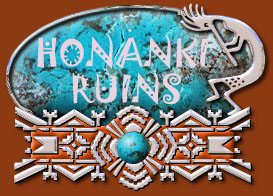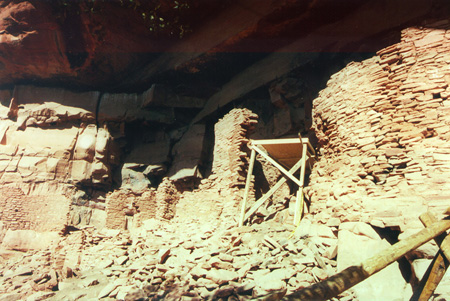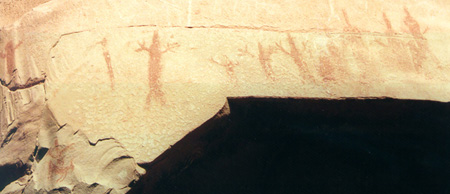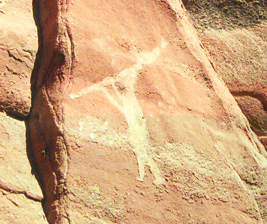

|
| The ruins at Loy Butte -- the official name for which is the Honanki Ruins -- were constructed approximately 800 years ago by the Sinagua. The area contains quite a few pictographs: Picto, from the Latin prefix "pictus", when added to graph means "pictured object used to convey an idea or information". The pictographs in this area are attributed to the Southern Sinagua culture known to inhabit the Sedona area approximately A.D. 650-1450 before mysteriously disappearing. However, it is possible that some drawings may have been created as early as 10,000 years ago. It is also believed that the Yavapai and Tonto-Apache tribes of later years left their marks, too. | |
|
|
 Honanki is the largest cliff dwelling ruin
in the Sedona region. The structure is situated in an alcove on the west side
of Loy Butte, adjacent to Lincoln Canyon. The Hopi word Honanki means “House of
the Badger.” The site was named in 1895 by Archeologist Jesse Walter Fewks of the
Smithsonian Institution after sighting a bear nearby. He had intended to name it
“Bear House,” but with less than perfect command of the language he missed the
spelling by one letter. Fewks estimated that the dwelling contained about 200 rooms
and accommodated a population of between 300 and 400. These ancient ruins probably
were occupied by Sinagua people between 1130 and 1280 A.D., a time frame determined by
examining wooden lintels used as supports for doors, windows and roofs. Honanki is the largest cliff dwelling ruin
in the Sedona region. The structure is situated in an alcove on the west side
of Loy Butte, adjacent to Lincoln Canyon. The Hopi word Honanki means “House of
the Badger.” The site was named in 1895 by Archeologist Jesse Walter Fewks of the
Smithsonian Institution after sighting a bear nearby. He had intended to name it
“Bear House,” but with less than perfect command of the language he missed the
spelling by one letter. Fewks estimated that the dwelling contained about 200 rooms
and accommodated a population of between 300 and 400. These ancient ruins probably
were occupied by Sinagua people between 1130 and 1280 A.D., a time frame determined by
examining wooden lintels used as supports for doors, windows and roofs. |
|
 Some of the pictographs
at Honanki. Some of the pictographs
at Honanki. |
|
 A pictograph of Kokopelli wearing some sort of
headdress and playing a flute. He is the ancient god of abundance and was called on
to bring forth many good things, such as bountiful crop, or children, etc. He is
also referred to as the 'Trickster' for his ability to enchant all creatures with his
mellifluous music. In this respect he bears a striking similarity to the pagan god
of nature, Pan. A pictograph of Kokopelli wearing some sort of
headdress and playing a flute. He is the ancient god of abundance and was called on
to bring forth many good things, such as bountiful crop, or children, etc. He is
also referred to as the 'Trickster' for his ability to enchant all creatures with his
mellifluous music. In this respect he bears a striking similarity to the pagan god
of nature, Pan. |
|
 Several species of yuccas are found in the Sedona
region. The one in this picture is preparing to bloom (note the towering, naked
pole-like stalk). Agaves
(aka the century plant) superficially resemble yuccas, except that agaves die after
blooming. The two plants are confused often, the principal reason
being that they both send up blossoms on a stalk. However, the agave's flowers are pale
yellow whereas the yucca's are white. The prehistoric Indians that lived in the Sedona
area used yucca leaves to weave baskets. Several species of yuccas are found in the Sedona
region. The one in this picture is preparing to bloom (note the towering, naked
pole-like stalk). Agaves
(aka the century plant) superficially resemble yuccas, except that agaves die after
blooming. The two plants are confused often, the principal reason
being that they both send up blossoms on a stalk. However, the agave's flowers are pale
yellow whereas the yucca's are white. The prehistoric Indians that lived in the Sedona
area used yucca leaves to weave baskets. |
|
    
© All pictures are Copyright 1999 - 2001 Grisel Gonzalez |